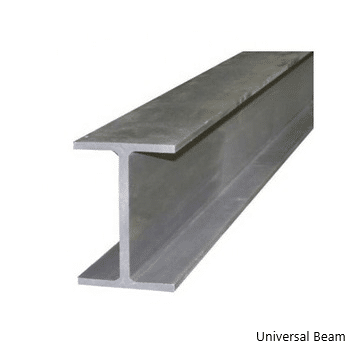This article explains different types of steel beams used to transfer loads from the structure to the adjacent column.
Various classifications can be made to identify types of steel beams. In this article, we classify beams based on their geometry and manufacturing process.
The following types of steel beams are discussed here.
- I beam, H beam, W and S profile
- License plate holder
- Girders/portal beams
- Rectangular hollow profile and circular hollow profile
- Composite beams
- Other types of beams
Let's discuss each beam type in detail.
I beam or universal beam
The I beam, also known as the universal beam, is a hot-rolled profile.
Universal beams are considered the most used steel profiles in construction. In most structures, these steel supports are connected to the universal beams to support the loads.


Universal beams have greater rigidity in the vertical direction to support loads. The section height is greater than the section width.
An I beam is also called an H beam when the section height and width are equal. In other words, the height of the section corresponds to the width of the flange.
Additionally, they are also identified as W and S sections.
The main problem with steel construction is fire resistance. When structural steel is exposed to fire, its temperature increases rapidly and the steel section also deforms rapidly.
Additionally, steel beams have lower load capacity or stiffness compared to concrete beams of the same height.
License plate holder
A plate girder is a steel beam mainly used in bridge construction.
These beams are types of customized steel beams. Adjustment is done based on project requirements.
Plate girder bridges are widely used on railway lines.
Two flanges and the web are connected by welding to form the beam. The construction of sheet metal beams is not the same as other types of beams .
Since the three plates are connected by welding, the quality of the weld must be checked regularly during welding. An additional test must be carried out to ensure that the weld was performed correctly and has sufficient strength.
Portal beam
A gantry crane is a mechanical system used to transport materials or goods from one location to another.
These systems are categorized depending on their intended use. In ports we use gantry cranes to lift containers, in factories we use gantry cranes to transport goods or materials from one place to another.
A gantry crane is a mobile device that transports a load. Additional movement of the weight along the beam can also be observed.
The design of gantry cranes can take into account applied loads, the effects of live loads, etc. In general, the construction of this type of steel beam is more difficult than other types.
Medium to small sized frames can be manufactured from hot rolled profiles. However, gantry cranes with heavy loads can also be designed as sheet metal girders.
Also, portal beams are called special steel beam designs.
Rectangular hollow profile and circular hollow profile
Most of the time these elements are used in trusses, pillars and beams.
The rectangular hollow cross-section and circular cross-section are more efficient in terms of local failures. Universal beams are more susceptible to local buckling due to their natural cross-section.
However, the rectangular hollow profile is more resistant to local dents.
Furthermore, rectangular hollow profiles are available in various cross sections. However, they are not generally made by joining steel plates together like sheet metal beams.
Composite beams
Composite action is a combination of two or more materials. Composite beams are the most efficient types of steel beams used in structural construction.
It can be a combination of a steel beam with the slab or the construction of a steel beam together with a concrete beam.
The connection between the steel beam and the plate is achieved using head screws. Shear bolts are welded to the steel beam and embedded in the concrete.


The composite effect of the beam when installing shear bolts can be taken into account when sizing the beam. Due to the simplicity of the design, it is observed that some engineers do not consider the composite effect in the design of the steel beam. This is not an economic construction.
Other types of beams
Angular profiles such as “C” channels, “L” angles, etc. They are also used as steel beams in construction. However, these types of steel beams are not commonly used as steel beams.
They are mainly used as elements of a structure or as part of a steel structure.

